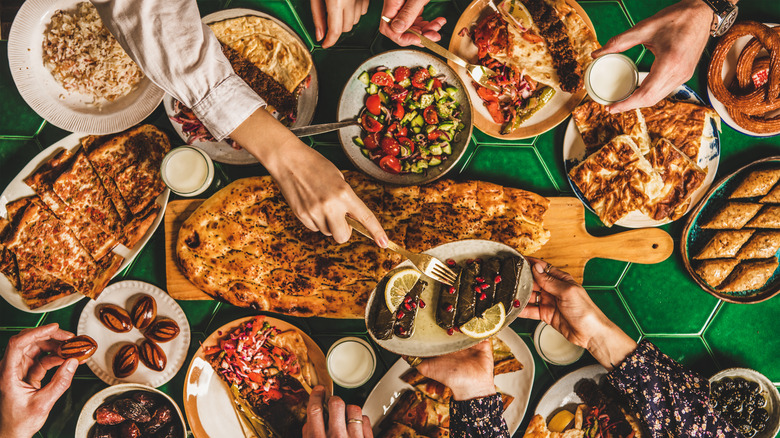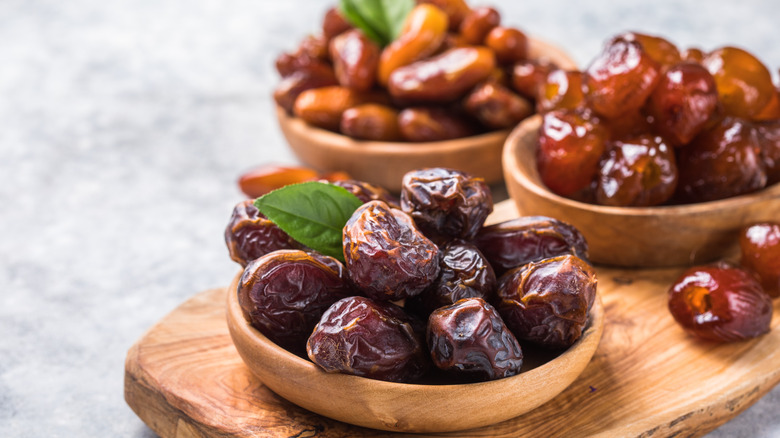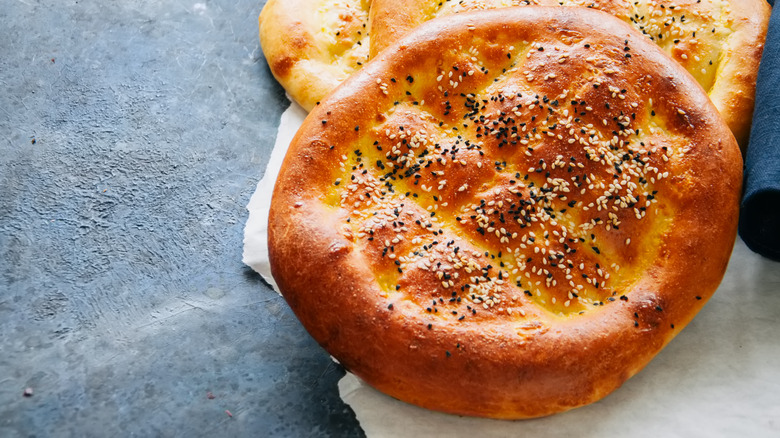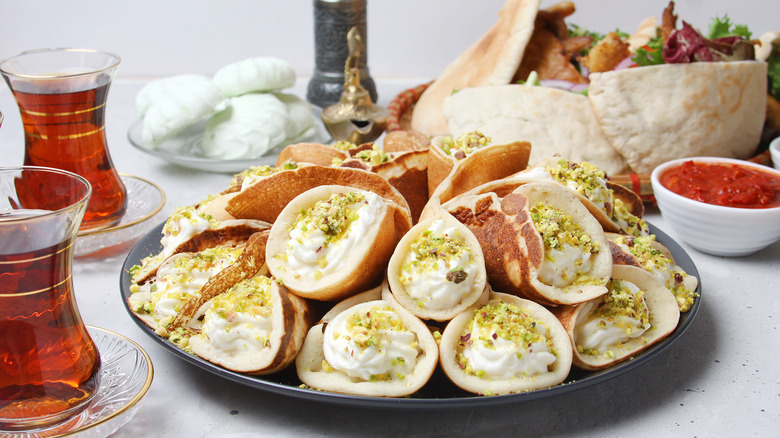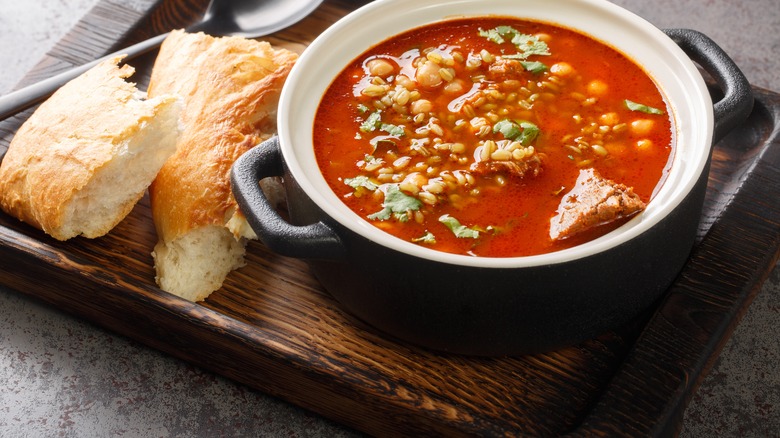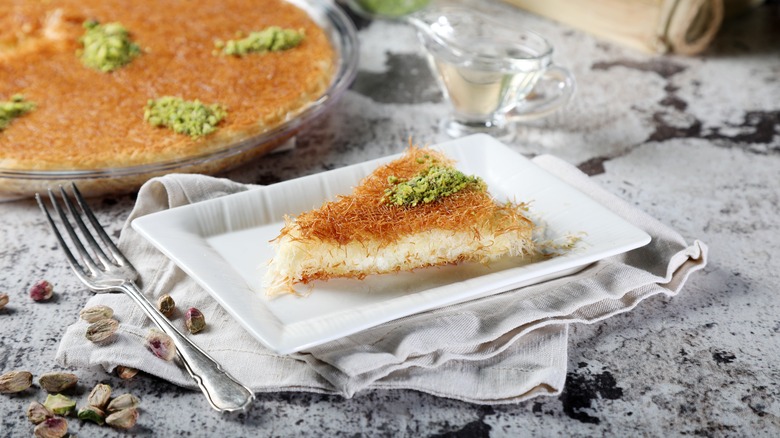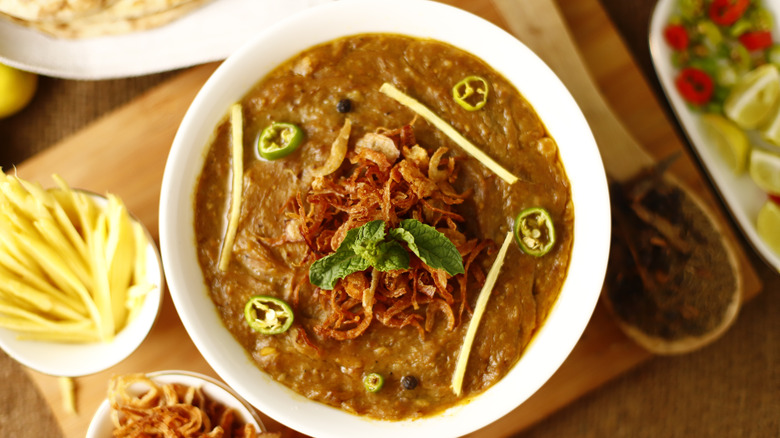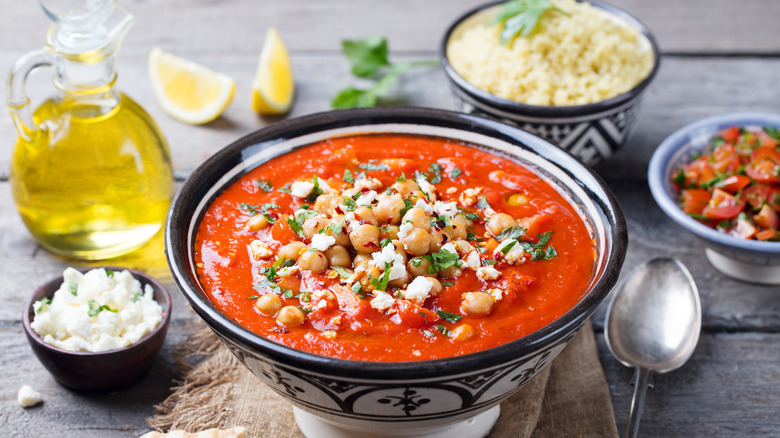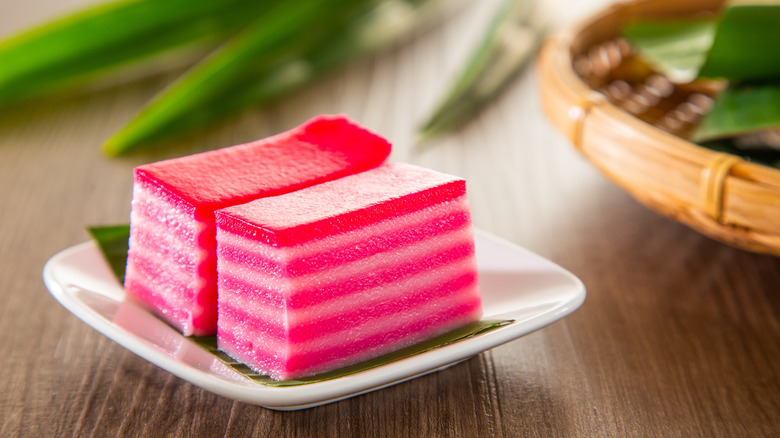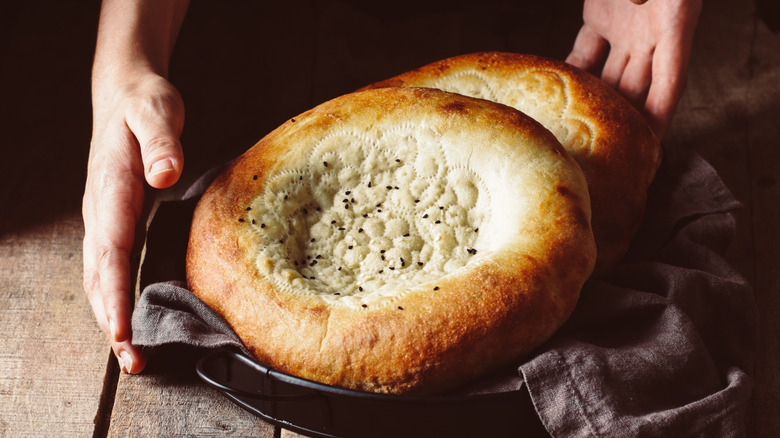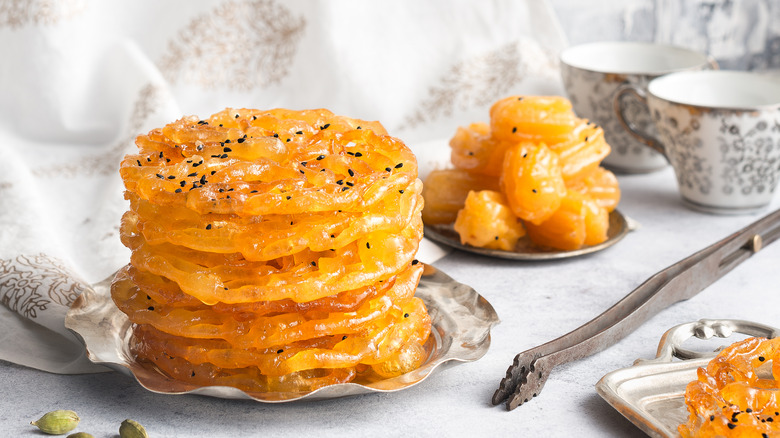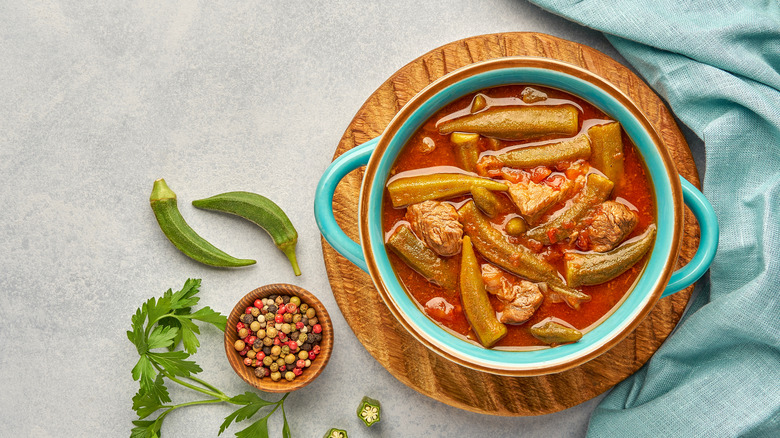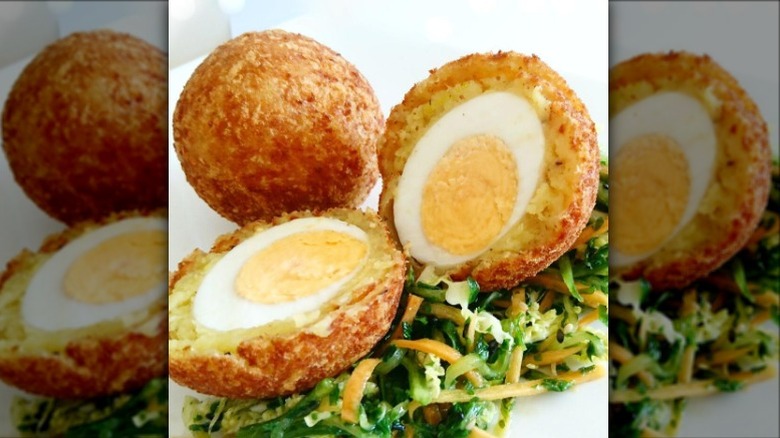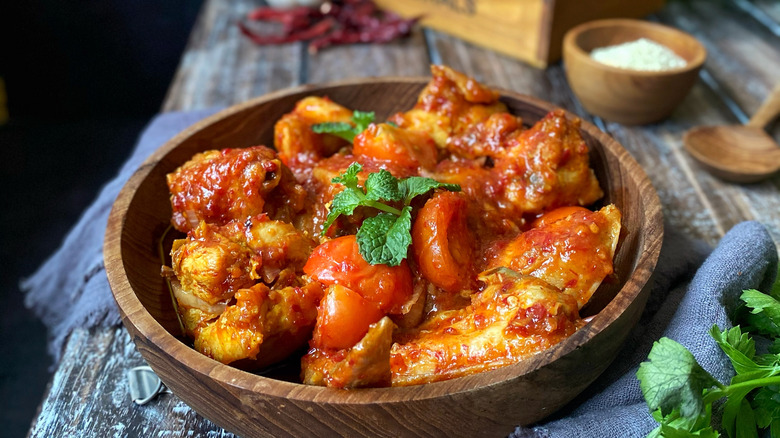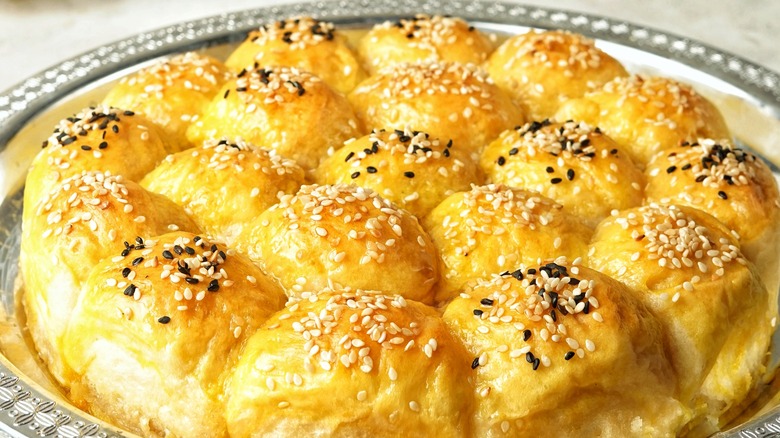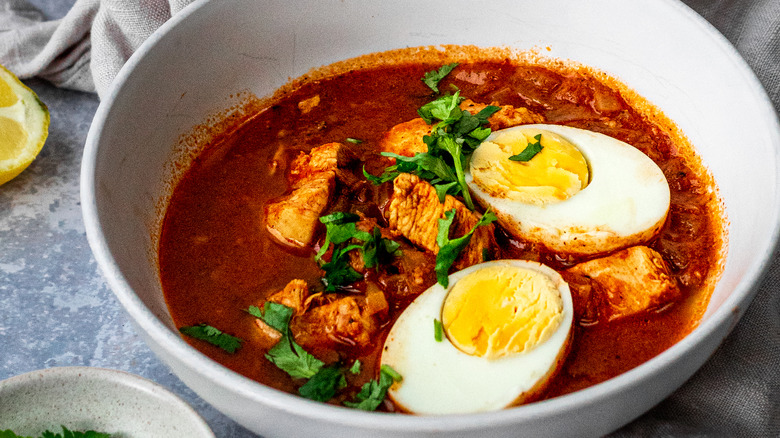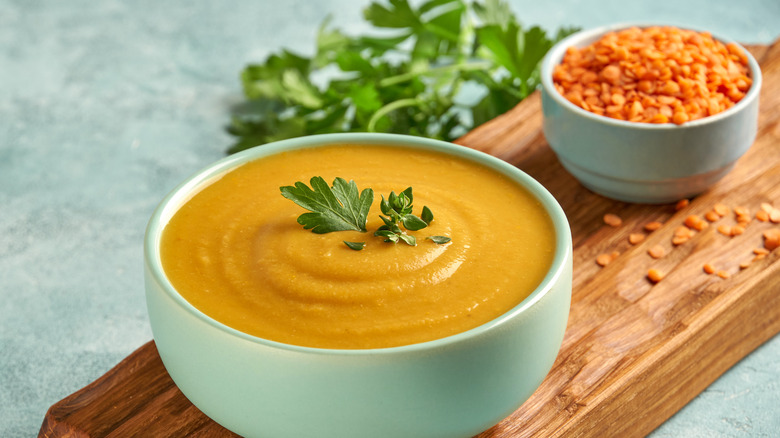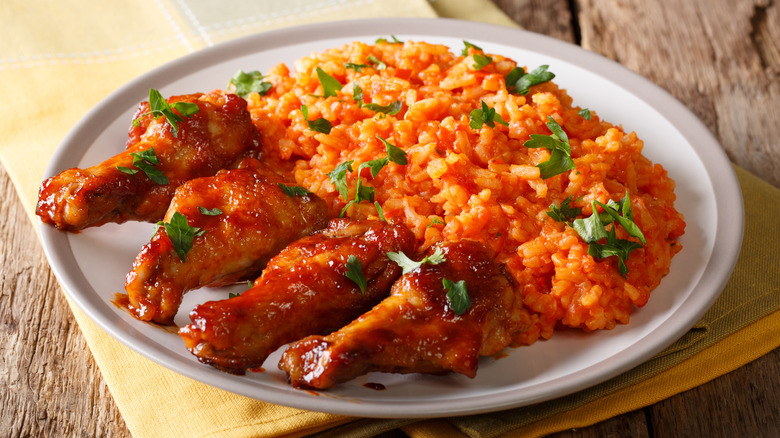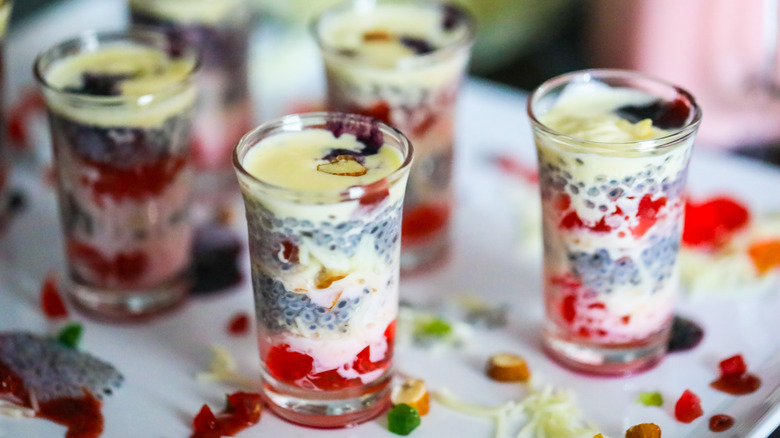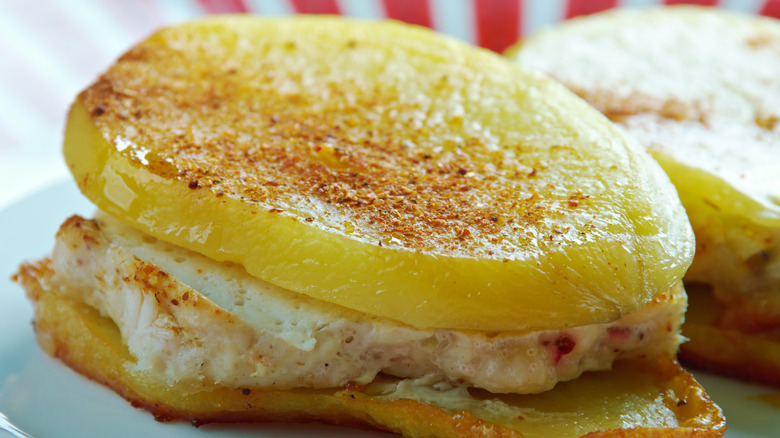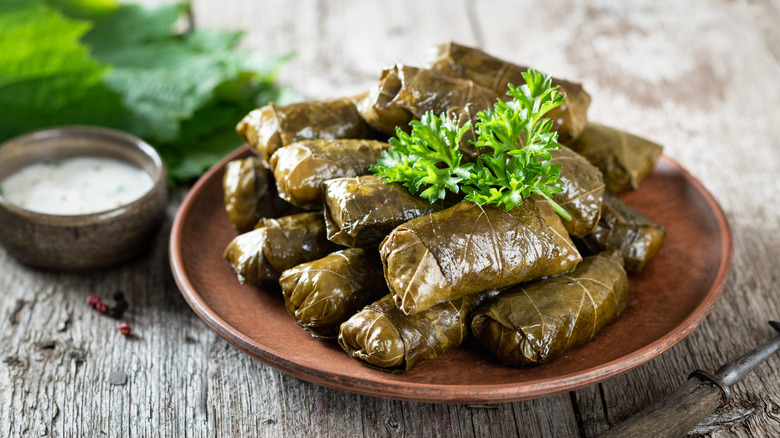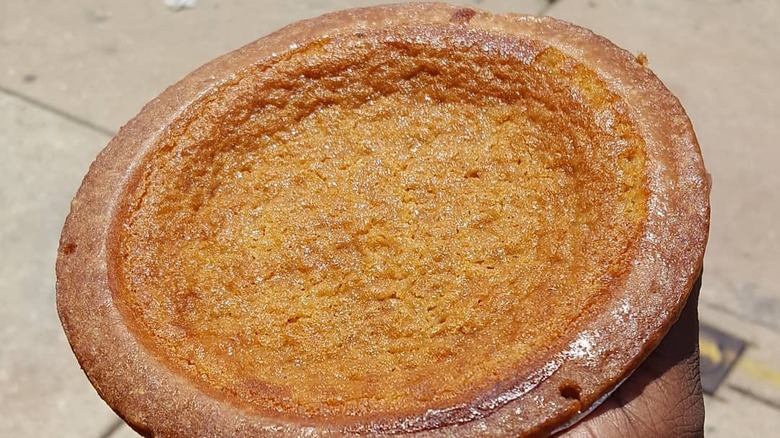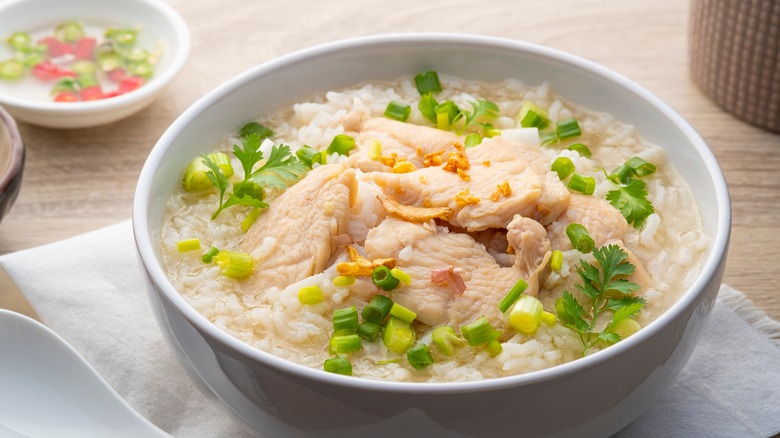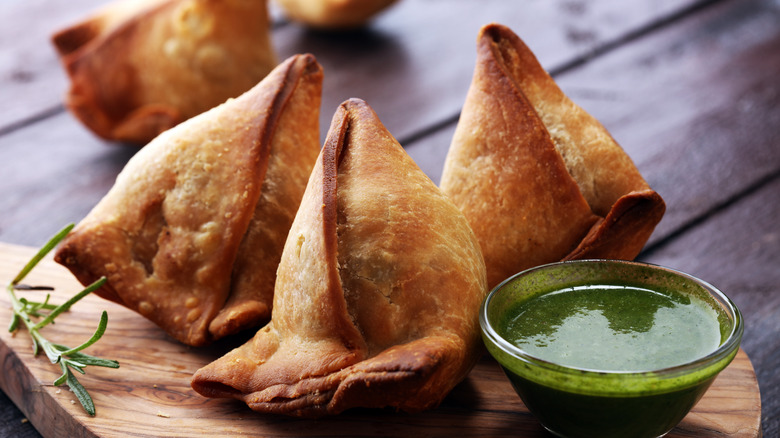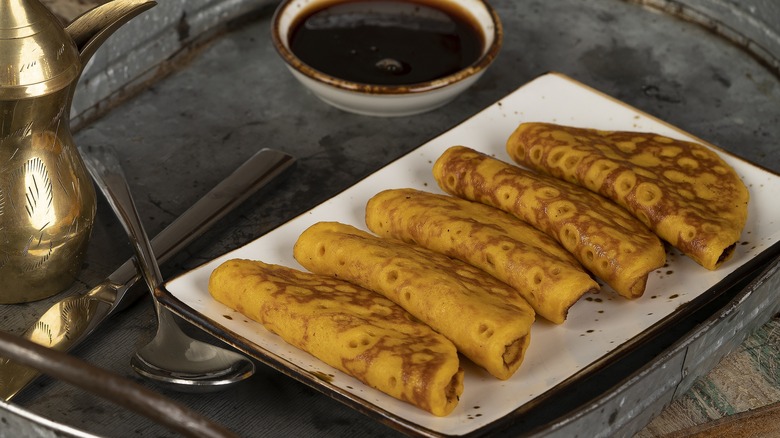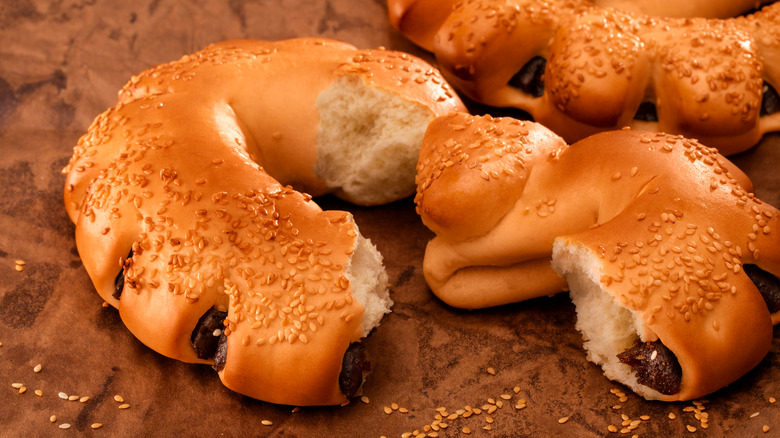25 Traditional Dishes Enjoyed For Ramadan Around The Globe
The time is fast approaching for millions of worshipers to celebrate the month-long festival of Ramadan. Ramadan's date varies each year as it follows the lunar-based Islamic calendar, and due to differing interpretations, some communities may start the festival a day earlier or later. The festival revolves around the five pillars of Islam, most notably prayer (salat), alms (zakat), and fasting (sawm). Throughout the month, able Muslims commit to a strict fast from dawn to sunset. This fast, which prohibits food or water, is undertaken to display spiritual discipline and commitment to Allah and as a reminder to empathize with and support those less fortunate.
Although it may seem counterintuitive, Ramadan is quite food-focused. Just under two billion Muslims worldwide wake before sunrise and enjoy Suhoor, a small meal that provides sustenance and energy throughout the day. It typically includes milk and dates, as well as various cultural favorites. Once the sun sets, families break their fast with Iftar, a large feast. Islamic teachings declare that Allah will bless anyone who provides Iftar for others, and they will never experience hunger or thirst again.
Ramadan culminates in Eid al-Fitr, celebrated with gift-giving and banquets. While Islam originated in Saudi Arabia, the religion has rapidly spread and is now present on all five inhabited continents. As a result, each country has its cultural foods associated with Eid al-Fitr, many of which we'll explore today.
Dates, Everywhere
If you live in a city with a substantial Muslim population, you may have noticed that your local supermarket has started stocking more dates than usual. Why? Eating dates is the traditional way to end your Ramadan fast, a custom rooted in history and inspired by the Prophet Muhammad. According to Islamic scripture, the Prophet Muhammad would break his fast by eating three dates and a sip of water. Many devout followers follow his example — it makes sense, as dates are high in natural sugars and ideal for regaining energy after fasting. While there are over 200 date varieties, the unique and sweet flavor of medjool dates makes them the most popular.
Ramazan pidesi, Turkey
Did you know that in the Ottoman era, there was a bakery for every need: for the military, the public, embassies, and charity? Though the bakeries from the past no longer exist, the ancient streets of Istanbul are still overflowing with bake shops. During Ramadan, people queue for hours to get their hands on freshly baked Ramazan pidesi, a fluffy leavened bread. Its distinctive indentations and toppings of sesame and nigella seeds give it a unique appearance.
A lavish spread featuring Turkish coffee, cheese, labneh, and jam alongside the pidesi is typical for Suhoor. Alternatively, one can savor çılbır (Turkish eggs) alongside the fluffy bread as a more robust Iftar meal.
Qatayef, Egypt
Once qatayef starts appearing in shops, you know that Ramadan has arrived. These sweets, traditionally eaten only at Ramadan, are synonymous with festive spirit for not just the people of Eygpt but all North African and Middle Eastern people. The main component of qatayef is a pancake made with flour, semolina, and yeast that is cooked on just one side. Two popular variations exist; the first has a sweet ashta (clotted cream) stuffing, is topped with nuts, then drizzled with honey — while the latter is sealed, fried, and soaked in sugar syrup. It's common to buy stacks of pancakes from the market and assemble the qatayef fresh at home.
Chorba frik, Algeria
If you're looking for a hearty and homely dish, soup always hits the spot. Chorba frik, a specialty of the Maghreb (Algeria, Libya, Mauritania, Morocco, and Tunisia), is a warming stew served in the winter months and an essential part of the Ramadan feasts. Tomatoes, chickpeas, various vegetables, and spices such as cinnamon, paprika, turmeric, and coriander melt into a rich, thick, and spicy sauce, while browned lamb adds a mouth-watering flavor. However, the main ingredient is freekeh, a popular ancient grain that originated in the region thousands of years ago. It has a nutty, earthy taste that compliments the succulent meat and delicate chickpeas.
Knafeh, Palestine
Countries beyond the U.S. and Europe also have a culinary history of delicious cheese-based desserts. Knafeh (also spelled kunafa, kanafe, or kunefe) is one of the Middle East's prized confections, although where it originated is still disputed. Some historians place the dessert definitively in Palestine, while more yet claim its origins are in Egypt or Syria. Whatever the case, knafeh has been bewitching people for centuries with its floral aroma and delectably sweet taste. The base of the dessert is mozzarella, which is topped with shredded phyllo (called kataïfi), then popped in the oven until melted and golden. A sweet floral syrup scented with rose and orange blossoms is poured on top, then a sprinkling of crushed pistachios completes the knafeh.
Haleem, Pakistan
Slow cooking is the secret to creating a successful haleem – a thick, fragrant, and hearty traditional Pakistani dish that tantalizes the taste buds. To make haleem, people cook meat, wheat or barley, lentils, nuts, and spices until it becomes unctuous and velvety. They usually garnish it with julienned ginger, caramelized crispy onions, and fresh cilantro to enhance the flavors. Although the dish has its roots in Iran, the Nizams of Hyderabad popularized the meal throughout India. Later, when many Muslims fled to the newly created Pakistan after the Partition of India, they adapted haleem into a festive special.
Harira, Morocco
Morrocan cuisine is rich in variety and flavor, but one dish is an absolute requisite on the Iftar menu: harira. This traditional Moroccan soup packs in flavor and, surprisingly, is often plant-based (although some interpretations contain meat). The name derives from the Arabic word "harir," meaning silk — a reference to the smooth, velvety texture. It's also bursting with chickpeas, tomatoes, lentils, parsley, cilantro, celery, vermicelli, ginger, and warming spices. The fresh herbs add a hint of zestiness, while the pulses are undeniably comforting. It's not hard to see why the whole country looks forward to steaming hot bowls of harira with crusty bread for Iftar.
Kuih lapis, Indonesia
Possibly the most vibrant of Ramadan desserts, kue lapis is a strikingly layered steamed cake originating from Indonesia. Its popularity has also spread across Malaysia, where the colorful dessert goes by the moniker "kuih." Chefs utilize a variety of natural ingredients indigenous to Southeast Asia to infuse the distinct layers with vivid hues, including butterfly pea flowers, pandan leaves, rose syrup, and pumpkin. The texture is soft and bouncy due to indigenous ingredients such as glutinous rice and tapioca, while coconut milk provides creaminess and cane sugar sweetness. As the month of Ramadan concludes and Eid al-Fitr approaches, street vendors dot the streets selling stacks of kue lapis. More traditional families devote themselves to lovingly crafting this delectable dessert using time-honored methods.
Patır, Uzbekistan
Historically, Uzbekistan — and much of Central Asia — have been Muslim countries. In 1924, that all changed. The Soviet Union occupied Uzbekistan and imposed the state religion, atheism, on its people. The perpetrators destroyed mosques, burned Arabic texts, and barred Muslims from holding office. It wasn't until 1991 that Muslim Uzbeks, who account for 90% of the country's population, could finally practice their religion without fear of persecution. Perhaps due to the dark history, in modern times, Ramadan remains a comparatively private affair without much pomp or splendor. However, it's common for the head of the family to hold a communal prayer, then break the evening fast with patır, a crispy and buttery bread baked in a traditional tandoor oven.
Zoolbia, Iran
If you're familiar with South Asian cuisine, you may recognize zoolbia — they resemble Indian jalebi and even share the same ingredients. This sweet treat is made from a saffron, yogurt, flour, and baking powder batter that's fermented for an hour, then piped into hot oil, taking the shape of spirals. Once fried, zoolbia is quickly dunked in a rose-scented sugar syrup, giving the sweet a tantalizingly crunchy texture and moreish sweet flavor. During Ramadan, people usually pair zoolbia with bamieh, a donut-like pastry similar to churros, and hot tea. Combining these traditional treats with a milky beverage creates a perfectly indulgent yet comforting taste for festive times.
Bamia, Lebanon
We know, we know. Okra — or ladies' fingers, as it's sometimes affectionately known — is a divisive vegetable. Bad experiences with slimy okra have disenchanted some, while others can't resist juicy okra pieces in a hearty gumbo. The secret to making the best of the vegetable is in your okra cooking method, and the Lebanese have got it down pat. Traditional bamia, a robust and wholesome okra and meat stew, will unequivocally change the minds of even the most ardent okra haters. The dish is delicious, infused with flavor from classic Lebanese spices, tangy pomegranate molasses, and rich tomato.
Nafaqo, Somalia
You've likely heard of Scotch eggs, but have you heard of their Somali cousin, nafaqo? It's unknown where either dish originated; some sources point to the Indian nargis kofta, while others point out similarities to snacks from North Africa. Unlike most other similar iterations of the dish, the Somali nafaqo is vegetarian — at the center is a perfectly soft-boiled egg wrapped in delicately seasoned mashed potato and then coated in crispy breadcrumbs. The tantalizing refreshment is a prevalent breakfast item but also has a special place amongst Ramadan foods. In Somali, the name "nafaqo" means "nutrition," and it's for this reason that it remains a popular fasting food to this day.
Ayam masak merah, Malaysia
There's no doubt that Malaysian cuisine is world-renowned for its deceptively spicy foods and complex flavors. However, we'd bet you haven't tried ayam masak merah, a fragrant chicken dish cooked in a mild, aromatic sauce. It's an absolute must-have for Malay Muslim families on Eid al-Fitr, and we recommend gathering the ingredients to cook your own when you get the chance.
At the base of most ayam masak merah recipes is sambal, a condiment made from dried red chilies, lemongrass, shallot, garlic, ginger, and other aromatics. It adds gentle heat to the otherwise mild dish, which makes the curry ideal for eating with ghee rice (nasi minyak).
Khaliat al nahl, Yemen
Do you love sweet bread, like cinnamon buns and babka? If so, you'll want to add Yemeni khaliat al nahl to your Iftar spread. The appellation translates to "honeycomb buns," referencing the dessert's distinct design, mimicking the beautiful honeycomb pattern. Each fluffy, cloud-like bun is stuffed with sweet cream cheese and topped with sesame and nigella seeds. And how could we forget — honeycomb bread wouldn't be complete without a brush of sweet, floral honey. The tempting buns are easy to tear and share and taste unbelievably good dipped in Yemeni coffee, some of the most special in the world.
Doro wat, Ethiopia
Unfortunately, Ethiopian food doesn't get the attention it deserves, especially considering knock-out dishes like Doro Wat. This mouth-watering chicken stew is famously spicy, the unofficial national dish of the country, and a Ramadan gem that's not to be missed. Tender chicken pieces, a thick buttery sauce called kulet, a fiery berbere spice blend, and hard-boiled eggs unite to create this irresistible dish. The sauce has a depth of flavor that can only be achieved by gradually caramelizing and drawing the sweetness out of the onions, so don't cut down on the cooking time. It's best served with a fermented flatbread, injera.
Shorbat adas, Jordan
Vegetarians rejoice. Since most Muslim cultures are renowned for rich and hearty meat-based dishes, you may be under the impression that there aren't many options for plant-based diets. You'd be wrong, though — start your culinary journey right with shorbat adas, a warming red lentil soup from Jordan and Lebanon. Though simple and unassuming, these lentils seasoned with earthy spices pack a flavorful punch. Squeeze some zesty fresh lemon on top to lift the dish to new heights, and tuck in. It's customary to serve shorbat adas for the first source in the Iftar feast, as it's light and refreshing.
Jollof rice, Nigeria
This vibrant one-pot meal is a staple in Nigeria, Ghana, and Senegal, with each country claiming to have the best jollof rice recipe. The meal consists of fluffy long-grain rice cooked in a rich tomato-based sauce, then seasoned with fiery curry powder, dried thyme, and bay leaves. Often, jollof rice is accompanied by crispy-fried chicken or fish and garnished with fried plantains (dodo) or coleslaw. As the country with the largest Muslim population in Africa, Nigerians celebrate the holy month of Ramadan with much zeal. And everyone agrees the celebration would be incomplete without large platters of their national dish, jollof rice.
Falooda, Bangladesh
By Ramadan, Bangladesh is already experiencing rather stiflingly hot and sunny weather. That's where falooda comes to the rescue, a sweet and refreshing dessert drink beloved in the area. Added to sweetened milk is a mixture of sweet vermicelli noodles, chilled rose syrup, jello, basil seeds, tapioca pearls, and chopped nuts. Traditionally, Bengali falooda is served in a tall glass and topped with a scoop of cold vanilla ice cream, extra nuts, and strands of saffron. The complex dessert blends different flavors and textures with stunning visual effects and is obligatory after a long day without drinking or eating.
M'battan, Libya
If there's one food we can't resist, it's fried potatoes. Universally adored, potatoes are one of the most accessible and versatile vegetables, with almost every country boasting a diverse snack made from crispy-cooked potatoes. In Libya, the dish of choice is m'battan, also spelled mubattan or batata mbatna. It may be unthinkable, but they've managed to create something even better than the potato fry — crispy on the outside, soft on the inside, potato slices stuffed with garlicky, herby minced meat. The m'battan is slightly fiddly to assemble, but once you start eating, all the prep work will be more than worthwhile.
Dolma, Iraq
Legend has it that dolma's widespread popularity is thanks to Alexander the Great's admiration for the Greek practice of wrapping leftovers in vine leaves. He was so taken with the technique that he introduced it to his military kitchen and took the tradition wherever he went, spreading the love for this delicious dish far and wide.
But what exactly is dolma? The treat involves wrapping seasoned rice, vegetables, or minced meat in tangy vine leaves. The leaves are steamed, then served with sweet and sour pomegranate molasses. Iraqis and their neighbors savor this finger food as part of their Iftar feast.
Bean Pie, U.S.
It may not be your first instinct to picture American food enjoyed as part of the Iftar banquet. Nonetheless, Islam is the third-largest religion in the U.S. (after Christianity and Judaism), with over 3.5 million devotees. While many of these adherents brought their traditional culinary delights to the U.S., some devised new meals. Bean pie is one such example, with a history dating back to the Black Muslim community of the 1930s. The founder of the "Nation of Islam," a popular movement of the era, advised his followers to eschew unhealthy starches along with haram foods like pork, alcohol, and gelatin. While many desserts were out of the question, avid bakers got imaginative and created the legendary bean pie, a creamy and silky dessert made from navy beans. It may sound disagreeable, but give it a try, and we promise you'll convert.
Arroz caldo, Philippines
All the best foods are comforting, wouldn't you agree? Whether it's food from our childhood or food which instantly sparks the feeling of coziness, those meals are always exceptionally tasty. For Filipinos, arroz caldo, their national dish, is the perfect homely and healthy Iftar meal. Arroz caldo features chicken, ginger, and garlic in a flavorful broth mixed with warm, creamy rice and topped with crispy fried garlic, scallions, and lime. Those craving a little extra protein can add soft-boiled eggs; the silky yolk provides an extra depth of flavor when mixed into the thick porridge, in addition to increasing its nutritional profile.
Samosa, India
While India remains a majority Hindu country, there is a substantial Muslim minority totaling around 200 million — this makes India the nation with the third highest population of Muslims. Given this, it's no surprise that Ramadan is a spectacular occasion throughout India, especially in hubs like Hyderabad and Delhi. Iftar feasts consist of many curries, bread, and rice dishes, but you'll find one particular snack on every dinner table. Samosas are deep-fried (although samosa can be made in the air-fryer) pastries with flaky, crisp, golden pastry and spiced potato with peas. Pair them with chutney, raita, or any combination of curries.
Chebab, United Arab Emirates
The United Arab Emirates' status as one of the wealthiest countries in the world is reflected in its vibrant restaurant scene, where chefs have a wealth of imported ingredients at their fingertips to create a diverse range of culinary delights. The country also has a rich culinary history, though, and one of its people's favorite dishes — especially for Ramadan — is Emirati chebab, a fluffy pancake. To make this delectable delicacy, blend saffron, cardamom, and warm milk to create a batter, and then cook it on a hot pan. The finishing touch is to drizzle the chebab with date syrup (or honey).
Ma'arouk, Syria
While many Suhoor, Iftar, and Eid al-Fitr banquets feature year-round favorites, some desserts are served only during Ramadan. In Syria and neighboring Lebanon, pillowy ma'arouk bread is one such treat. Anticipation builds among children and adults as they eagerly await the chance to savor the brioche-like bread. Ma'arouk dough is infused with aromatic mahlab, then stuffed with delectable date paste and finely chopped mixed nuts, creating a sweet-spicy mix integral to the flavor. Traditionally, ma'arouk is shaped into a wreath, baked until golden, brushed with citrus-infused sugar syrup, and served with numerous cheeses, jam, hot tea, or coffee.
Static Media owns and operates Tasting Table and Mashed.
